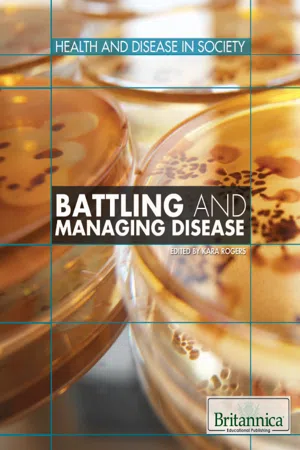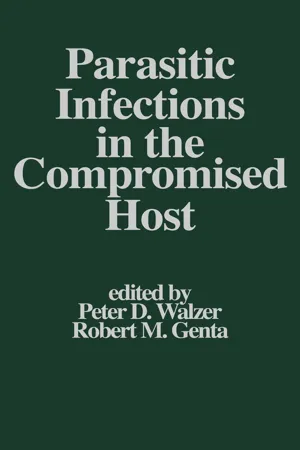Biological Sciences
Susceptible Host
A susceptible host is an individual who is at risk of contracting a disease or infection due to their lack of immunity or resistance to the pathogen. This can be due to various factors such as age, genetics, underlying health conditions, or lifestyle choices. Identifying susceptible hosts is important in preventing the spread of infectious diseases.
Written by Perlego with AI-assistance
Related key terms
Related key terms
1 of 4
Related key terms
1 of 3
3 Key excerpts on "Susceptible Host"
- eBook - ePub
- Britannica Educational Publishing, Kara Rogers(Authors)
- 2010(Publication Date)
- Britannica Educational Publishing(Publisher)
Up to this point, diseases caused by biotic agents have been considered in terms of the role of the invader. Equally important is the role of the host, the individual who contracts the disease. Any infectious disease is a test between the invader and the defender. Virulent organisms may be capable of inducing serious illness even in the most robust host. The converse is perhaps more important. The weak host is prey to many forms of biotic infection, even those of low virulence and invasiveness. Some of the more important of the many factors that condition the level of resistance to biotic infection in the individual are age, with infancy and old age being times of maximum vulnerability; poor nutrition; genetic disorders and immunosuppressive agents, such as the human immunodeficiency virus (HIV), that compromise the immunologic system; and metabolic disorders such as diabetes that increase vulnerability to infectious agents.Therapeutic agents, paradoxically, also have become important factors in predisposing to disease of biotic origin and indeed in altering the incidence patterns of infectious disease. The drugs that are principally involved include those used to suppress the immune response, as well as the host of antimicrobial and antibiotic agents now employed in the treatment of infectious disease. Immunosuppressive drugs are used to block the immune response in patients about to receive an organ transplant and in the treatment of the autoimmune diseases, but such treatment renders the patient vulnerable to attack by biotic agents. Indeed, these immunologically compromised persons become susceptible to organisms of extremely low virulence.Antimicrobial drugs also have drawbacks as well as benefits. A patient suffering from a streptococcal disease, for example, may appropriately be treated with penicillin. Certain strains of staphylococci, however, are resistant to penicillin. Although the streptococcal organisms, as well as other commensals, may be eradicated by the antibiotic, the resistant staphylococci begin to proliferate, possibly because the competition with other bacteria for nutrients and food supply has been removed. In this noncompetitive situation they may cause disease. More powerful antibiotics may destroy all bacteria, including staphylococci, but permit the unrestrained proliferation of fungi and other agents of low virulence that are nonetheless resistant to the antibiotic. Thus antibiotics have changed the entire frequency pattern of biotic disease. Organisms that have proved to be more resistant to antibiotics have become the more common causes of serious clinical infection. For this reason certain forms of drug-resistant bacteria that include Escherichia coli, Aerobacter aerogenes, Pseudomonas aeruginosa , and strains of Proteus - eBook - ePub
- Marinus te Pas, Henri Woelders, André Bannink, Marinus te Pas, Henri Woelders, André Bannink(Authors)
- 2011(Publication Date)
- Wiley-Blackwell(Publisher)
In a general sense, the research field of host–pathogen interactions is well developed due to its impact and importance of infectious diseases that threaten human and animal health. The field is closely linked to our growing fundamental understanding of the host's innate and adaptive immune system and to our current understanding of the wide variety of mechanisms that pathogenic microorganisms use to invade, reside, and replicate within hosts. Quantitative and qualitative aspects of host–pathogen interactions determine whether pathogens are able to invade hosts, survive and replicate, spread throughout the body, and transmitted to other hosts. These aspects also determine the pathology and severity of the disease resulting from the interplay between host and pathogen: either elimination or colonization of the microbe without causing clinical signs of disease, or colonization of the microbe causing diseas, ranging from mild to deadly. Both microbial virulence as well as host disease susceptibilities are frequently seen as traits of pathogens and hosts, respectively. However, this is not correct since both depend on dynamic interactions between the two (Casadevall and Pirofski, 2000).Recent studies focusing on host–pathogen interactions increasingly use high-throughput -omics technologies that generate ten to several hundred of thousands of data points. They provide genome-wide global views of the molecular structures and molecular compositions of biological samples. Such studies have shed light on several virulence strategies used by microbes, on a number of defense strategies used by hosts, and on several mechanisms by which the interactions between hosts and pathogens are influenced by external factors, such as nutrition and stress. However, biological functions do not simply manifest themselves from the addition of the properties of system components, but rather arise from the dynamic interactions of these components. In addition, individual studies usually focus on one specific biological level, i.e., genes, cytokines, or macrophage activity, on particular cells or tissues, i.e., dendritic cells (DCs) or spleen, a particular time frame, and either host-response or pathogen inference. However, to understand the genetics and physiology of host–pathogen interactions, it is required to get data information from different time frames and different scales, i.e., genes, molecules, networks, pathways, cells (host as well as pathogens), tissues, organs, organisms. - eBook - ePub
- Peter D. Walzer, Robert M. Genta(Authors)
- 2020(Publication Date)
- CRC Press(Publisher)
3 ). This is a state in which adult worms are well established in the host, at the same time inducing an immune response that limits further infection by the infective stages of the parasite.Third, if parasites reside in anatomical sites secluded from the host immune response, chronic infections can occur. This appears to be the case in intestinal helminthiases in which organisms such as hookworms, Ascaris lumbricoides, and Strongyloides stercoralis appear to exist for extremely long periods of time despite immune responsiveness (both humoral and cellular) on the part of the host (4 ).III. Genetic and Environmental Determinants of Susceptibility to InfectionWhile rapid progress has been made in defining the genetic basis of susceptibility to protozoal infection (5 ), largely by the use of inbred strains of mice, relatively less work has been done in infections due to helminth parasites. Nevertheless, there has been a growing interest in this field, as epidemiological studies in endemic areas have revealed differential susceptibilities to infection within the entire population as well as within families studied (6 ). Since disease seems to develop only in the presence of immune responsiveness on the part of the host, factors modulating or affecting this responsiveness have been sought both experimentally and clinically. Some of these data have been reviewed elsewhere (7 ).Although the cause of differential susceptibility to clinical expression of helminth infections has been addressed in only a few human studies, the data have implicated, in part, the major histocompatibility complex (MHC). In Sri Lankians and southern Indians with elephantiasis due to Wuchereria bancrofti infection, there was an association between HLA-B15 and the pesence of chronic lymphatic obstruction (8 ). Further, when a large Polynesian population living in an endemic area for bancroftian filariasis was studied, familial clustering of patients was seen, suggesting genetic transmission of the disease susecptibility (9 ). However, the "genetics" of this familial susceptibility was linked to neither their HLA-A nor HLA-B loci. More recently, work done in mice (10 ) and with human filarial-specific T-cell clones (11
Index pages curate the most relevant extracts from our library of academic textbooks. They’ve been created using an in-house natural language model (NLM), each adding context and meaning to key research topics.
Explore more topic indexes
Explore more topic indexes
1 of 6
Explore more topic indexes
1 of 4


